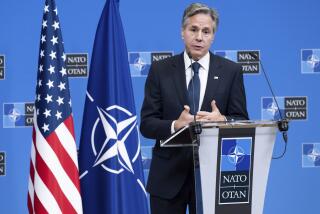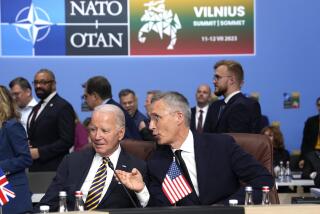D-DAY INVASION / June 6, 1944 : THE INVASION OF NORMANDY : THE LEGACY
- Share via
News of the D-day landings traveled far and fast.
In the United States, newspaper extras carried banner headlines of the Allied assault on the Normandy beaches of northern France. In Nazi-occupied Europe the accounts spread by short-wave radio from Britain.
One week shy of her 15th birthday, an excited Jewish girl in Amsterdam named Anne Frank described in the June 6, 1944, entry to her diary how she and her family huddled around a radio in their attic hideaway to hear details of the invasion.
“This is the day,” she wrote. “ . . . I have the feeling friends are approaching.”
While it was quickly understood that D-day would alter the course of World War II irrevocably in the Allies’ favor, not even the most farsighted visionaries were in a position to grasp the event’s lasting significance:
That the 70,000 Americans who set foot in Northern Europe on that gray, stormy June day were the vanguard of a U.S. presence that would not just help win the war, but remain to preside over a half-century of peace.
For the United States, D-day was part of a watershed.
For Europe it was more.
For better or worse, the Normandy invasion was one of a series of events that propelled America past the point of no return on the road toward a permanent global role, a permanent European presence and its first peacetime alliance.
Psychologically and politically, the U.S. casualties taken that day and during the subsequent 11 months of fighting until Nazi Germany’s surrender gave America little option but to push aside instinct, reject a return to isolationism and instead stay on to help preserve the peace in Europe.
In the years since, about 16 million American service personnel and their dependents have served in Europe.
Only the collapse of communism, a deepening budgetary crisis and a string of pressing domestic problems have led Washington to begin unwinding its presence in the region. From a peak of 325,000 in 1989, U.S. troop strength in Europe now stands at about 150,000. It is scheduled to fall to 109,000 by the end of 1996.
The troop withdrawal reflects a larger shift in America’s national priorities--those now embodied in Bill Clinton, a young President with no personal memories of Europe’s disastrous war and committed far more to tackling long-neglected domestic ills than strengthening U.S. influence abroad.
As a result, more question marks hang over the future of the transatlantic relationship than at any time since the Iron Curtain fell across Europe. For Europeans, adrift on a sea of frightening new problems and searching to redefine themselves and their role in a post-Cold War world, this ebbing American interest is disturbing.
After all, they owe a lot to their transatlantic partner.
It was, for example, the American military and economic support in the early postwar years that halted the Soviet Union’s westward advance, steadied governments vulnerable to Communist takeover in France, Italy and Greece and kept West Berlin alive with a 15-month airlift.
As Soviet Cold War bullying intensified, it was a U.S. president, John F. Kennedy, who traveled to Germany, reminded Moscow that the defense of America began in Berlin, then declared himself a citizen of the beleaguered city with his famous declaration, “Ich bin ein Berliner.”
It was U.S. pressure that helped pave the way for Germany’s swift rehabilitation into the community of Western democracies and American money that flowed into an exhausted Western Europe under the Marshall Plan, restoring hope and igniting an unprecedented economic recovery.
And it was leaders such as Dean Acheson, Dwight D. Eisenhower and John Foster Dulles, who repeatedly gave crucial support to the French visionary Jean Monnet as he worked to overcome regional jealousies to build a European Common Market.
“We’ve all buried the amazing importance of America in process of European integration,” said William Wallace, a senior research fellow at Oxford University’s St. Antony’s College. “The whole thing was American-driven.”
Added Pierre Jacquet, deputy director of the French Institute of International Relations, “Without it (the American presence), Europe would have fallen back again into the 1930s, with nations trying to export their problems to each other.”
Instead, the Common Market’s successor--the European Union--stands at the center of the Continent’s future. It is about to enlarge from 12 to 16 member states and--albeit hesitantly--has reached out to the former Soviet satellite states in the east. EU member nations still squabble with each other, but war between them is only a slightly less remote possibility than armed conflict between California and Nevada.
Amid this transatlantic success, there have been bitter differences--many of them stemming from frictions inherent in a relationship between peoples who share the same values but in vastly different worlds.
American policy-makers, especially in the 1970s and 1980s, frequently complained of limp, pessimistic European allies, too paralyzed by their own self-doubts to be effective partners. Presidents Lyndon B. Johnson and Richard Nixon all but ignored Western Europe as the United States pursued a war in Asia, detente with Moscow and an opening of ties with Communist China.
The Vietnam War debacle, coupled with Western Europe’s growing economic strength, the student revolutions that swept the region in 1968 and the dollar crises of the early 1970s, ended the European sense of awe for America that characterized much of the relationship’s early years.
Some sharp foreign policy clashes during the Jimmy Carter and Ronald Reagan presidencies and a love-hate relationship with the growing American cultural invasion led many Europeans to nurture a new stereotype of the United States--that of a powerful, but naive ally, whose quick-trigger, overly simplistic world view constituted a danger only slightly less than that emanating from Moscow.
But few on either side of the Atlantic could challenge the reality that Western Europe’s stunning revival had unfolded and matured under the protection of America’s security guarantees. Indeed, many argue that both a long-term American political role and military presence in Europe remain vital for the Continent’s stability.
Anyone watching the EU’s futile efforts to prevent conflicts on its own within the region would be hard-pressed not to agree. The war in the former Yugoslav federation, the first major political crisis postwar Europeans have had to face without immediate American leadership, has been both a diplomatic disaster and a demoralizing blow to the EU’s self-confidence--in addition to a great human tragedy.
“Our biggest problem is that for the last 50 years, America has told us what to do,” said Wallace, the Oxford fellow. “We may not have liked it, but it always gave us a starting point. Now this is gone.”
Added Stanley Crossick, chairman of the Belmont European Policy Center, a Brussels-based political think tank:
“We got things right after the war because of strong U.S. leadership, the brilliance of the Marshall Plan and the vision of our own statesmen. Now we no longer have the same U.S. leadership, our own leaders are weak and there’s no Marshall Plan.”
But there remain many elements that will keep America and Europe locked together.
Despite the new importance of Japan and other Asian markets, Western Europe remains America’s biggest overseas trading partner. Since 1945, the Old World has drawn an estimated $200 billion in U.S. private investment--roughly 40 cents of every American dollar invested overseas. The $195 billion in EU-U.S. trade last year accounted for more than one quarter of all global exports.
Such figures help support the claim that America’s decision to defend Western Europe was no act of altruism, but far more a policy based on enlightened self-interest that has paid off.
A number of other imperatives would also seem to guarantee a continued strong transatlantic link. Common problems, including immigration, the preservation of democratic values and free markets, growing challenges from Asia and the emerging economies in the South remain common ground for both.
After fighting bitterly against each other through seven years of global trade talks, Europeans quickly teamed with Americans early this year to force the issues of child labor and worker exploitation onto the agenda of the newly formed World Trade Organization.
“The European Union and the United States have the most important interdependent relationship in the world,” concluded EU Commissioner Christiane Scrivener in a speech last month.
Although dazzled by the potential of fast-growing markets in the Far East, American policy-makers have found it hard to penetrate the Asian mind-set, let alone the markets themselves. In trying to cultivate Asian markets, the Clinton Administration has already stumbled into open conflicts with several nations, including Japan, China, Malaysia and Singapore.
Meanwhile, a powerful transatlantic cultural bond has emerged, that, despite European ambivalence, continues to grow. From the GI chewing gum, jazz music and Ernest Hemingway paperbacks in the late 1940s, to the Levi’s, NFL sweat shirts, Pizza Hut restaurants, hard-rock music, Hollywood films and TV game shows found virtually everywhere in Western Europe, American soft power has steamrollered the Continent.
It is a truth that makes many Europeans wince, but 3 1/2 decades after the Treaty of Rome committed them to the path of integration, the common thread through Western European mass culture is American.
“At the mass level, it has contributed to a cultural homogenization across Europe,” declared Philipp Borinski, part of an academic team at Mainz University that is studying the future of the transatlantic relationship.
American pop music, scientific writings and successful business styles helped catapult English into the role of a de facto international language, adding further to this cultural impact. Widespread knowledge of English has made Northern Europe especially vulnerable to American influence and, although the Romanesque countries to the south have resisted this trend, they too have succumbed, at least in part.
“These countries are more influenced than they like to admit,” noted Wilfried Wiegand, who edits the cultural pages of Germany’s leading national daily, the Frankfurter Allgemeine Zeitung. “In Italy it’s now fashionable for young people to eat hamburgers and learn English. In a country that values form and elegance, this is a way for young people to show they are different.”
In Germany, American ideas flooded into a cultural vacuum left in the wake of Nazism. Probably nowhere else in Europe have American habits and tastes--from jazz clubs to corporate boardrooms--taken greater hold.
While the reaction to the Vietnam War and the 1968 student protests both carried a distinctly anti-American character and worked to tarnish America’s image as a political role model, they paradoxically strengthened the American cultural impact.
With few home-grown symbols to challenge the Establishment, Western Europe’s young revolutionaries listened to the protest messages of Joan Baez and Bob Dylan, cultivated Andy Warhol’s art and adopted Eldridge Cleaver and Angela Davis as political heroes.
“It was a lifestyle revolution in the direction of America,” said Borinski, who views 1968 as a clear break from traditional West European mores, one that has brought Europe permanently closer to the United States.
He argued that American cultural influence has generated a greater sense of personal freedom in Germany, eroded authoritarian strains within society, and generally boosted the status and confidence of the individual--all developments that have enabled western Germans to thrive in a free-market, democratic environment.
“There’s a sort of social, cultural convergence taking place that’s making (Western) Europe and the U.S. more similar,” Borinski said.
“I think it has a positive effect in that it helps create a much broader understanding--above all among younger generations, which have been welded together in a common youth culture.”
But if decades of American cultural influence have narrowed the Atlantic, they have deepened the divide that still separates Germany and Europe nearly five years after the fall of the Berlin Wall.
The contrast in experience, in outlook, and in social values along with such things as people skills and personal confidence still visibly separate eastern and western Germans. These differences also divide Europeans elsewhere between those who were and were not under the American umbrella.
The resurgent popularity of retooled Communist parties in Eastern Europe does not reflect a nostalgia for life under the Soviet yoke, but it does represent a lingering sympathy for the socialist ideals and a protectionist state.
While many Europeans are ill at ease with the intrusions of Americana, only the French have cared enough to seriously fight it. Over the years, they have launched a series of counterattacks--most notably in December, when they fought to the last bitter minute to successfully retain their leaky defenses against the growing influx of American films and television programs during global trade negotiations.
Declaring the defense of the French language a “political priority,” Prime Minister Edouard Balladur’s government has also passed a law requiring that a minimum of 40% of all songs played over the country’s airwaves be in French and issued an official dictionary of some 3,500 new terms, such as restauration rapide instead of fast food and disque audionumerique instead of compact disc, to replace Anglicisms that have crept into the language.
Concern about American influence is nothing new in France. It was nearly 30 years ago that the French publisher J.J. Servan-Schreiber warned of “the flood of American industrial power into Europe.” In his 1967 bestseller, “The American Challenge,” Servan-Schreiber painted Western Europe’s plight in Draconian terms:
“Today’s generation faces a . . . clear choice of building an independent Europe or letting it become an annex of the United States. The sheer weight of American power is pushing our hesitant countries along the path of annexation.”
A generation later, those fears seem highly overdrawn, although a walk through Paris is proof that Americana is well entrenched. A tiny sandwich shop just off the Place de la Bastille, for example, seemed typically French--except for the Hollywood chewing gum, the Jack Daniels whiskey, the Getaway pinball machine in the corner, the framed photo of a Harley-Davidson motorcycle on the wall.
While the lure of Americana seems likely to remain for the foreseeable future, in other areas the transatlantic link appears less solid. America’s reduced political involvement raises troubling questions at a time when Western European leaders stare at a bewildering mix of new problems.
To the east, an unstable Russia and a string of bubbling ethnic disputes in the fledgling post-Communist democracies threaten instability.
At home, West Europeans struggle to contain growing immigration and rising unemployment. They watch neo-Nazis chase foreigners through the streets of Magdeburg and listen to Italy’s new parliamentary Speaker praise Benito Mussolini’s policies toward women.
“The situation . . . clearly begs the question: Who protects Europe against its demons once reasonableness is swept away?” German historian Michael Stuermer wrote recently.
Summed up Jacquet, the French foreign policy specialist, “Europe is undergoing its greatest crisis since the Treaty of Rome. It’s an identity crisis (and) Europe is just not ready.”
Ready or not, for the first time since Americans set foot in northern France to help free the Continent from Nazism 50 years ago, Europeans are facing the reality of reduced American involvement.
Some, such as Crossick, the Brussels think tank chairman, believe that--barring earlier explosions--the Continent’s long-term future will likely be determined in 1996 when the EU states meet to review the 1991 Maastricht Treaty that committed them to political and economic union. The 1996 review amounts to a de facto West European constitutional convention.
“We’ve got to get our act together,” Crossick said. “Unless we take a lot of important decisions (then) and carry the public with us, the battle for (a united) Europe could be lost.”
Crossick, along with others interviewed for this article, believe American involvement remains crucial for the Continent’s future.
But when President Clinton joins a legion of other Western leaders next week on the Normandy beaches to commemorate the 50th anniversary of the historic landings, he comes to a Europe of vastly different expectations.
The Amsterdam hideaway where Anne Frank and her family once listened to D-day unfold is a well-kept museum in a city whose richness and vibrancy symbolize the accomplishments of the new Old World--one increasingly ready for a new, more equal, transatlantic tie.
“We’re not asking for any favors, we’re not asking for money or concessions,” Crossick said. “We’re asking to work as partners to stabilize the world--but not against anyone.”
European Union
By providing military and diplomatic support after World War II, America became the midwife at the birth of the Common Market, now called the European Union.
* Initial members (1958)
Germany
Luxembourg
France
Belgium
Netherlands
Italy
* Second group (by 1986)
Ireland
Britain
Denmark
Portugal
Spain
Greece
* Pending membership
Norway
Sweden
Finland
Austria
More to Read
Sign up for Essential California
The most important California stories and recommendations in your inbox every morning.
You may occasionally receive promotional content from the Los Angeles Times.










